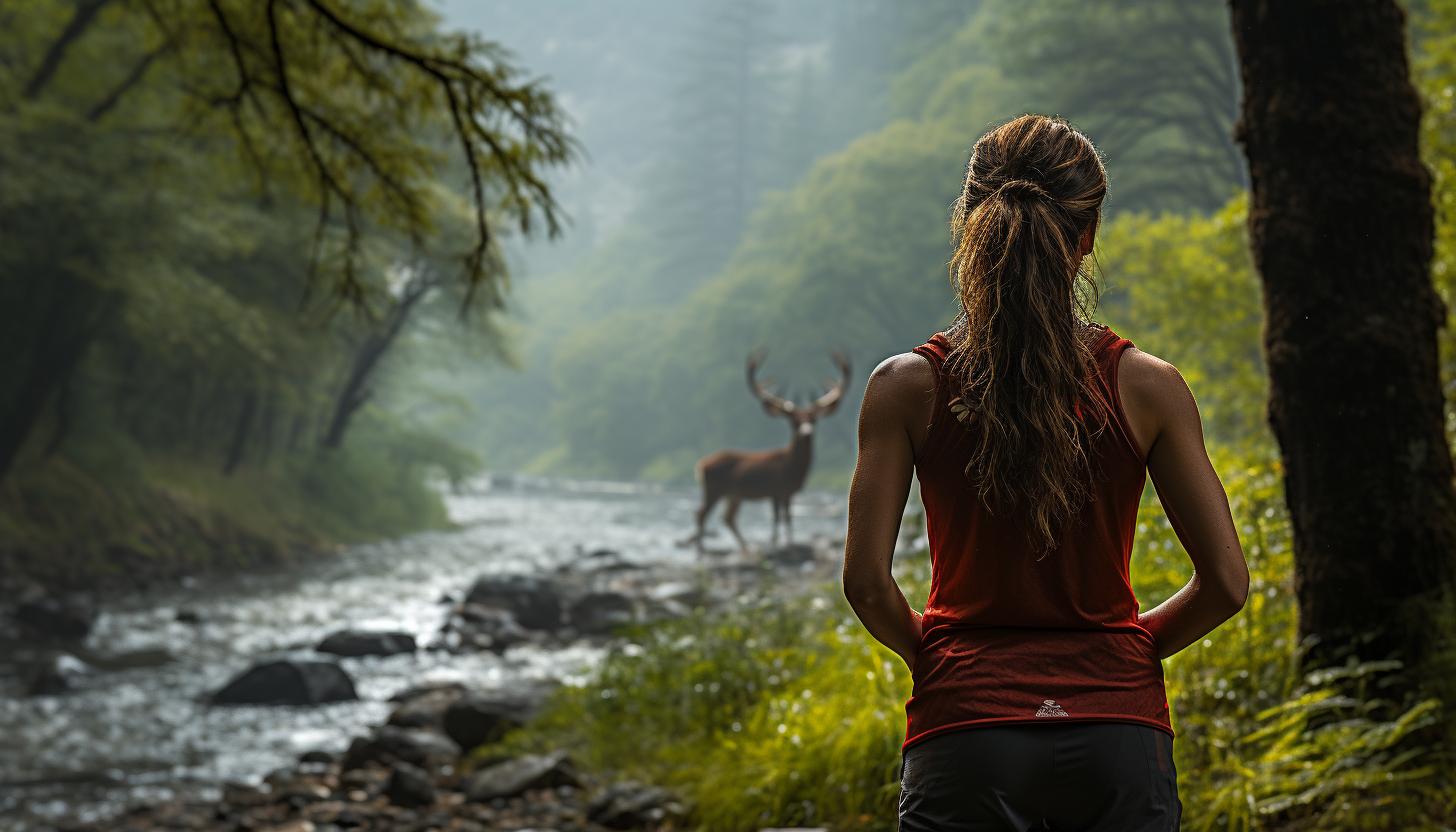Trail Running Safety: Dealing With Wildlife and Environmental Hazards

Imagine yourself on a beautiful trail, surrounded by breathtaking scenery and feeling the rush of adrenaline as you run.
But amidst the excitement, there are potential dangers lurking in nature’s playground.
In this article, we will guide you through the world of trail running safety, equipping you with knowledge to handle wildlife encounters and environmental hazards.
From bears to snakes to insects, we’ll show you how to stay safe while enjoying your favorite outdoor activity.
Identifying Common Wildlife Encounters

When you’re trail running, it’s important to know how to identify common wildlife encounters. Being aware of your surroundings and knowing what signs to look for can help you avoid potentially dangerous situations. One key aspect is avoiding encounters with aggressive mammals. If you come across a mammal in the wild, keep your distance and do not approach it. Certain species like bears, cougars, or wolves may exhibit signs of aggression such as growling, snapping their jaws, or raising their tails. These are clear indications that they feel threatened and could attack if provoked.
Another crucial skill is recognizing the signs of potential wildlife threats. Keep an eye out for tracks on the trail or scat left behind by animals. You might spot claw marks on trees indicating a bear’s presence or hear rustling sounds in the bushes suggesting a hidden creature nearby. Pay attention to any unusual behavior from birds or small mammals as they may signal the presence of predators in the area.
Understanding these basic guidelines will greatly enhance your safety while trail running. Remember to stay vigilant and respect wildlife habitats when enjoying nature’s beauty.
Now that you have learned about identifying common wildlife encounters, let’s explore some precautions for running in bear country.
Precautions for Running in Bear Country

To stay safe while running in bear country, remember to make noise and carry bear spray. Bear encounters can be dangerous if proper precautions are not taken. Bears have a strong sense of smell and hearing, so making noise as you run will alert them to your presence and help avoid surprise encounters. Additionally, carrying bear spray is essential for self-defense in case of an aggressive bear encounter.
Here are some important bear safety precautions to keep in mind:
| Precautions | Explanation |
|---|---|
| Make noise | Talking or singing loudly while running will alert bears to your presence and give them the opportunity to move away. |
| Carry bear spray | Bear spray is a highly effective deterrent against aggressive bears. Ensure that it is easily accessible and familiarize yourself with how to use it properly. |
| Avoid running at dawn or dusk | These are peak activity times for bears, so try to plan your runs during daylight hours when visibility is better. |
| Stay alert |
By following these precautions, you can minimize the risk of negative bear encounters while enjoying your trail runs safely.
Now let’s transition into the subsequent section about dealing with snakes and other reptiles on the trail.
Dealing With Snakes and Other Reptiles on the Trail

Stay aware of your surroundings and watch out for snakes and other reptiles while you’re out on the trail. Snake encounters can be alarming, but by following some simple guidelines, you can ensure your safety and minimize any potential risks. Here are a few key points to keep in mind:
– Stay on the designated trail: Stick to well-marked paths to avoid accidentally stumbling upon a snake or disturbing their habitat.
– Wear appropriate footwear: Opt for closed-toe shoes or boots that provide protection against bites.
– Use caution near rock piles and dense vegetation: Snakes often seek shelter in these areas, so tread carefully and give them ample space.
– Avoid tall grasses and bushes: These areas can conceal snakes, making it difficult to spot them until it’s too late.
– Know how to react if you encounter a snake: Remain calm, back away slowly, and give the snake plenty of room to retreat.
By being aware of these guidelines, you can greatly reduce the chances of an unwanted reptile encounter during your trail runs.
Now let’s transition into the next section about staying safe around dangerous insects and spiders.
Staying Safe Around Dangerous Insects and Spiders

Watch out for dangerous insects and spiders while you’re out on the trail. It’s important to be aware of these creatures and take precautions to prevent tick bites and avoid bee stings.
Ticks are small, blood-sucking parasites that can transmit diseases such as Lyme disease. To prevent tick bites, wear long pants tucked into your socks and use insect repellent containing DEET on exposed skin. After your run, thoroughly check your body for ticks, paying close attention to areas like armpits, groin, and scalp.
When it comes to avoiding bee stings, stay calm if you encounter a bee or wasp. Don’t swat at them or make sudden movements that could provoke an attack. Be cautious around flowering plants as they attract bees and other pollinators. If a bee approaches you, slowly walk away without making any sudden gestures.
Spiders can also be found along the trail but most are harmless. However, it’s still best to avoid contact with them by staying on designated paths and avoiding tall grasses or piles of leaves where spiders may hide.
Protecting Yourself From Environmental Hazards

Be aware of your surroundings and take necessary precautions to stay safe from potential dangers in the environment. When venturing out on a trail run, it is important to be mindful of the various environmental hazards that can pose a threat to your safety. Here are some tips to help you prevent accidents and ensure a safer trail running experience:
– Stay on marked trails: Straying off the designated path increases the risk of encountering dangerous terrain or getting lost.
– Watch out for slippery surfaces: Wet rocks, moss-covered logs, and muddy patches can cause you to slip and fall. Take caution when running on these surfaces.
– Avoid overgrown areas: Overgrown vegetation may conceal hidden obstacles such as tree roots or sharp branches, so stick to well-maintained trails.
– Check weather conditions beforehand: Be prepared for changing weather conditions by checking forecasts before heading out. Extreme weather can create hazardous situations.
– Report any trail maintenance issues: If you notice any damaged bridges, fallen trees, or other hazards along the trail, report them to authorities or local park services for prompt repair.
By following these guidelines and being proactive in preventing accidents, you can enjoy your trail runs while minimizing risks associated with environmental hazards.
Conclusion
In conclusion, when it comes to trail running safety, being prepared and informed is key. By identifying common wildlife encounters and taking the necessary precautions in bear country, you can ensure your safety on the trails.
Remember to stay alert for snakes and other reptiles, and know how to react if you encounter them. Additionally, protect yourself from dangerous insects and spiders by wearing appropriate clothing and using repellents.
Lastly, be mindful of environmental hazards such as uneven terrain or inclement weather. So lace up your shoes, embrace the beauty of nature, but always prioritize your safety along the way.






